How to Remodel a Wall
by: Dale Cox
Remodeling a wall to install a new opening requires a bit of "demo" work and removing plaster, drywall, and framing will kick up a lot of dust. To minimize clean-up, cover all furniture and tape plastic over all openings to contain the dust while remodeling. Also, wear a dust mask and safety glasses when breaking plaster off walls to protect yourself from the debris.
Locate the New Wall Opening
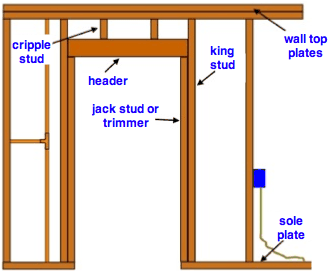
Choose the location of the new door or window and determine if any plumbing or wiring will be affected by the new installation. Look in the attic or basement to locate pipes and wires. If no access is available to these spaces, use a hammer to knock small holes in the wall to find plumbing and electrical systems.
If plumbing pipes are discovered to be in the space for the new opening, try to find another location that will do as well but doesn't require relocating plumbing. Moving other obstacles will always be easier than moving plumbing. It will be easier, for instance, to relocate an electrical box than a water pipe.
Removing Trim Moldings

Begin the wall demolition by removing the baseboard. You'll need to drive a wide blade behind the molding to pry it off without damaging the wood. Start by running a sharp utility knife along the top of the profile where it meets the wall to cut any caulk that may be sealing it to the wall. Next, use a wide chisel-bladed joint knife wedged behind the molding to begin to loosen it. Drive the blade behind the baseboard at each wall stud and pull out on the handle a few times to begin loosening the nails. When the gap is wide enough, hold a piece of plywood against the wall to protect it and slip a claw hammer or crowbar behind the molding to pry it completely off.
How to Remove Drywall for Remodeling
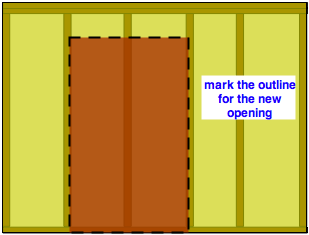
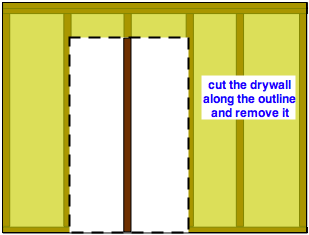
With the moldings removed, locate an existing wall stud that can serve as one of the king studs for the new frame. Check out this article for help making the choice and use the measurements from the framing instructions to mark the wall for the new opening.
From the inside of the chosen stud, measure along the floor to the location where the second king stud will be and then mark the wall at that point. Measure up to where the new header will be and use a level to draw a plumb line from the floor marks up the wall to that location. At the header location, use the level to draw a straight line connecting the two sides.
To remove drywall first cut along the lines with a reciprocating saw or a drywall saw in the hollow parts between the studs. Use the shortest possible blade on the reciprocating saw and hold it at a slight upward angle while cutting to minimize the chances of hitting the opposite wall as it moves in and out.
Knock a hole in the drywall with a hammer to insert the saw blade. Push it all the way in and press the base firmly against the wall surface. Keep firm pressure against the drywall while operating the saw to avoid vibrations that can damage the wall or cause injury.
After the outline is cut out along the hollow parts, cut the drywall over the studs by scoring several times with a sharp utility knife until it's cut completely through. Next, break the drywall out of the opening by hand. Use the side of the hammer to make an opening large enough to get a grip and pull the drywall off in pieces. Bag the pieces and then finish by removing any nails or screws from the exposed studs.
How to Remove Plaster to Remodel a Wall
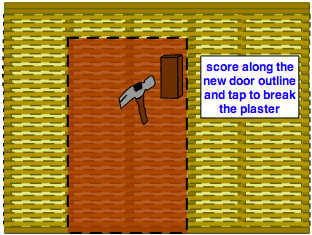
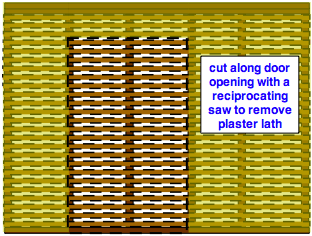
Use the same method described above to draw an outline for an opening. Plaster is very brittle so to minimize damage to the surrounding wall, tape along the outer edge of the outline with masking tape. Next, score the outline using a utility knife or the side of a sharp chisel. Score repeatedly and deeply (an eighth inch or more) to encourage the plaster to break cleanly along the line. The plaster putty coat is very abrasive and will dull a knife blade very quickly, so plan on replacing the blades as needed when using a utility knife for scoring.
Along the score line, use a 2x4 block and hammer to tap the wall just inside the outline. Break the plaster coat down to the lath all the way around the perimeter of the opening. Use a chisel-blade joint knife and hammer to cut any plaster that doesn't break along the line. Then use a sledge hammer or the side of a claw hammer to break the plaster brown and putty coats free from the wood lath in the center of the opening.
With all the plaster removed, use a reciprocating saw to cut the wood lath strips along the outline of the opening. To avoid vibrations that will crack the surrounding plaster, keep the base of the saw pressed firmly against the surface as you cut. After all the pieces are cut, pry the wood free from the framing using a crowbar and claw hammer. Remove all remaining nails and screws from the framing. You're now ready to cut the studs for the new door or window installation.
 Three Coat Plaster Repair
Three Coat Plaster Repair Framing for a Window
Framing for a Window Framing for a Door
Framing for a Door